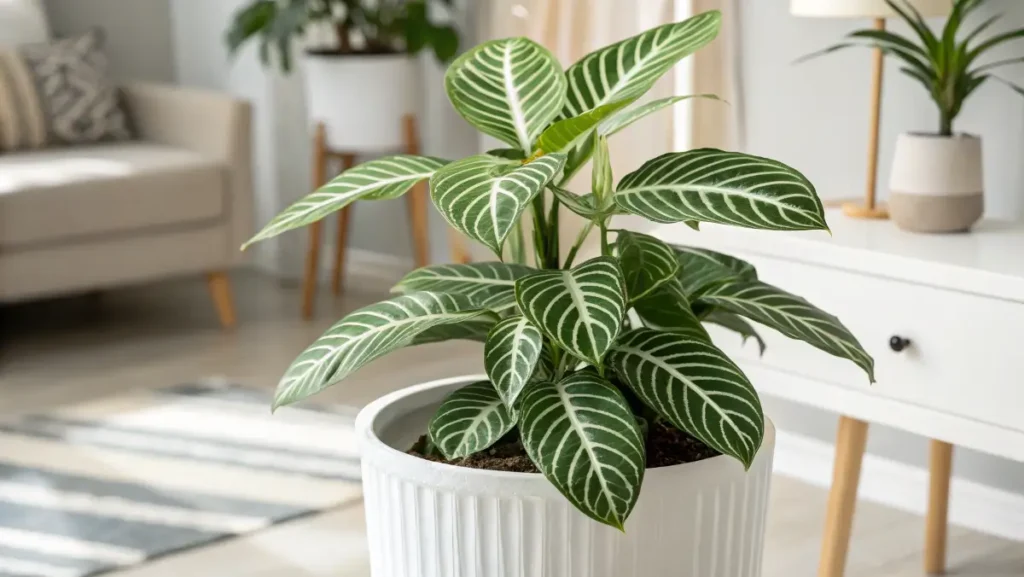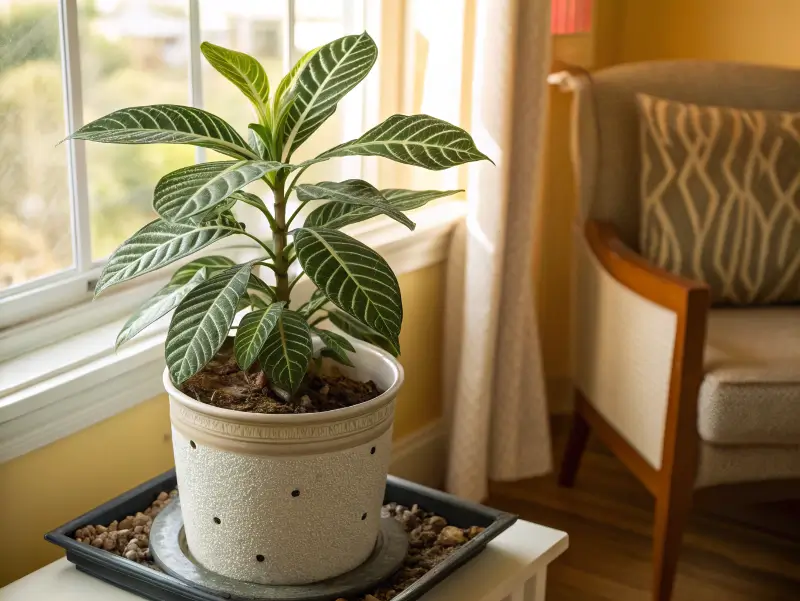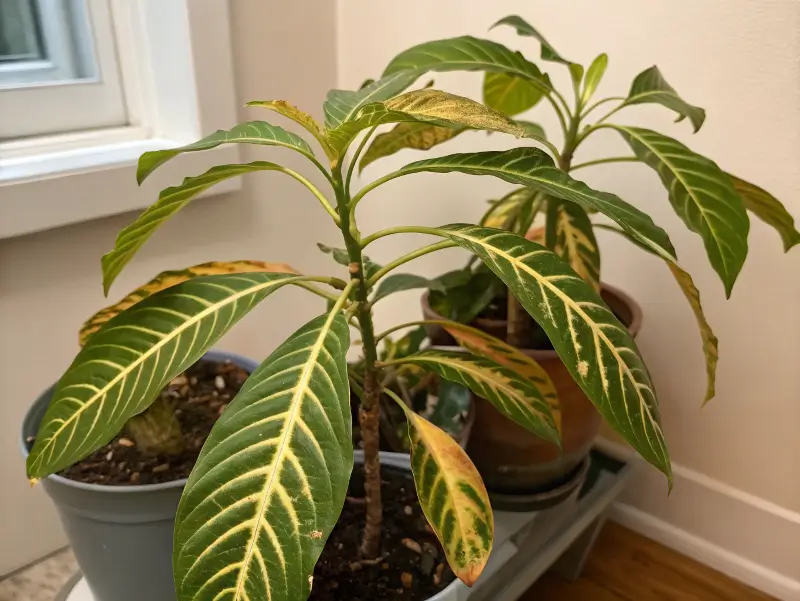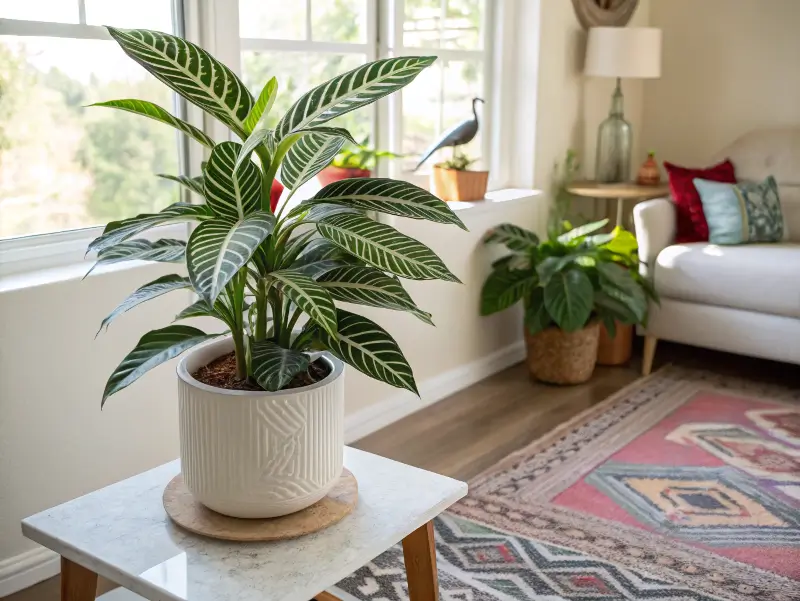
I’m honestly so pumped to chat about the zebra plant because it has quickly become my go-to houseplant for adding bold stripes and tropical flair to any room. In this article, I’ll share my experiences with caring for this eye-catching plant, the nitty-gritty of its origins, and why it steals the show among other indoor greenery. We’re talking easy tips for watering, feeding, and handling unexpected issues—plus, I’ll throw in my personal tricks for styling it in your home (tiny apartment or big house, it doesn’t matter). By the end, you’ll be ready to rock your very own zebra plant like a pro!
Table of Contents
Introduction to the Zebra Plant
What Is a Zebra Plant?
I first stumbled upon a zebra plant last fall during a local plant sale, and I just couldn’t resist those stripes. This striking houseplant typically refers to the Aphelandra squarrosa species, which has broad, glossy leaves patterned with bright veins. Many folks also call it the aphelandra zebra, probably because of its striped leaves and its genus name. Some people get it mixed up with Haworthiopsis (a succulent), but let’s face it, they’re pretty different in how they grow and how much water they need.
A Quick Look at Aphelandra Squarrosa’s Background
- Native to Brazil’s tropical forests
- Thrives in humid, warm spots
- Usually grown indoors for its bold foliage
If you’ve been thinking of getting a dramatic indoor plant, you won’t regret choosing a zebra plant. Its stripes turn heads, and its presence brings a lush vibe to any space, especially during these cooler spring 2025 evenings when we all want a little greenery inside.
Botanical Characteristics of Zebra Plants
Striking Leaves and Growth Habits
The zebra plant is known for:
- Large, dark-green leaves with bright, creamy or white veins
- Oval or elliptical shape that can grow several inches long
- Potential for a seasonal zebra plant flower that appears as brilliant bracts on mature plants
I once caught my aphelandra zebra sending out bright yellow bracts in late summer, and I nearly flipped from excitement. It felt like a mini tropical party right in my living room.
Aphelandra vs. Succulent “Zebra”
On the other hand, you might come across a different “zebra” labeled as Haworthiopsis—often a succulent with ridges and bumps. When someone says zebra plant at the nursery, I always check whether it’s the succulent or the big-leaf Aphelandra. The succulent version (sometimes linked to “zebra haworthia care”) needs way less water. Meanwhile, a aphelandra zebra with wide leaves demands more frequent, careful watering.
Even though both have stripes, they require different routines. I personally love them both: the Aphelandra for those large, showy leaves, and the Haworthiopsis for that compact succulent charm.
Ideal Growing Conditions for a Zebra Plant

Light and Temperature Basics
A zebra plant loves bright, indirect light. I’ve learned the hard way that direct sun can scorch its leaves, so placing it next to a window with a simple sheer curtain works wonders. Here in early spring, the sunlight is pleasant, but I still prefer a little shade. Temperature-wise, keep it in the 65°F to 80°F zone because sudden chills can cause stress, leading to droopy leaves or worse.
Soil, Drainage, and Airflow
When I pot my aphelandra zebra, I look for:
- Well-draining soil (often a peat-based mix)
- A container with drainage holes
- Pebble layer at the bottom to channel extra water away
Keeping the soil airy is key. Those roots love moisture but get upset if they’re sitting in waterlogged dirt. More air means fewer nightmares with root rot, so I never skip that part. To keep humidity up, I sometimes:
- Mist the leaves a few times a week
- Place a tray of water and pebbles nearby
- Group it with other plants that also like humidity
How to Care for Your Zebra Plant
Watering Schedule and Humidity Tips
I’ve got a simple routine for aphelandra squarrosa care:
- Water only when the top inch of soil feels slightly dry
- Avoid drenching the roots—moist but not sopping
- Use room-temperature water (especially in colder months)
In super dry indoor air, you might see the edges of leaves browning. So I keep the air moist by either running a small humidifier or setting the plant near a pebble tray. The aphelandra squarrosa has tropical heritage, so it thrives with a bit of added moisture.
Fertilizing and Light Feeding
During the growing season—from spring into early fall—I go with a balanced indoor plant fertilizer about once a month. This mild feeding helps the zebra plant grow new leaves and stay vibrant. However, I skip it during winter to let the plant chill.
I also talk to it sometimes—call me weird, but you know how folks say talking to plants helps them grow? Maybe it does, maybe it doesn’t, but it sure makes me feel connected to my green buddies.
Common Problems and Troubleshooting

Yellowing Leaves, Droopiness, and Leaf Drop
Sometimes an aphelandra squarrosa can drop leaves if the watering schedule is off. Last winter, I overwatered mine, and boy, did it penalize me with yellow leaves. If that happens:
- Check soil moisture. If it’s soggy, scale back on watering.
- Make sure you’re not blasting it with cold AC drafts.
- Snip off any dead or yellow leaves to keep it tidy.
Pest Issues
Keep an eye out for:
- Mealybugs (white cottony stuff)
- Spider mites (tiny webbing)
- Aphids (small green insects)
A gentle insecticidal soap can handle minor infestations. Wipe leaves, too, because these bugs love to hide in leaf joints. If you want an external reference for more pest management tips, the USDA has plenty of plant-friendly insights. Staying on top of pests is part of basic indoor plant care routine, and aphelandra zebra appreciates a bug-free environment.
Propagation Methods for the Zebra Plant
Stem Cuttings for Aphelandra Squarrosa
If you’re eager to share a zebra plant with a friend, stem cuttings work well. I usually:
- Cut a healthy stem below a leaf node
- Strip off the lower leaves
- Dip the cut tip in rooting hormone (optional, but helpful)
- Place it in water or a damp peat-perlite mix
Then, I cover it loosely with a plastic bag to keep moisture in. After a couple of weeks, roots should appear. Check that the water stays clean if you’re rooting in water. Once roots grow an inch or so, you can move the cutting into a proper pot.
Dividing Offsets
Occasionally, a mature aphelandra zebra might produce side shoots. Gently separate these shoots from the main stem with a clean knife. Pot them separately in the same well-draining mix. Keep things moist and warm, and you’ll have more zebra plants to show off or give away—leading to that satisfying sense of accomplishment for any plant parent.
Decorative Uses and Styling Ideas

Creating a Tropical Corner
When I decorate, I love mixing a zebra plant with other lush houseplants. It pairs beautifully with:
- A vibrant Lipstick Plant
- A tall Bird of Paradise plant
- Succulents that enjoy indirect light
The stripes add flair, so cluster it with contrasting leaf shapes for maximum wow. I’ve even tried combining it with a zebra grass plant, although that’s more of an outdoor ornamental grass. Paired together, though, they create a playful “zebra zone.”
Boosting Indoor Aesthetics
- Display it near a window where the light highlights those stripes
- Place it in a decorative pot that echoes its leaf pattern
- Group it with different heights to create a layered, mini-jungle look
I personally shift my aphelandra squarrosa around the living room depending on my mood—sometimes next to a reading chair, other times as the centerpiece on a plant stand. You can experiment and see what fits your vibe.
Zebra Plant vs. Other Houseplants
Comparing to Aloe and Succulents
If you’re new to stripes, you might mix up a zebra grass plant outside with a succulent “zebra” indoors. They’re all unique, though! Aloes can have spotted leaves, while haworthias have bumpy stripes. A typical succulent “zebra” needs less water and more light. Meanwhile, the big-leaf zebra plant (Aphelandra) needs moderate watering and consistent humidity.
I learned that difference the hard way by accidentally watering my Haworthiopsis too often (oops!). Thankfully, I recognized the signs of soggy soil and let it dry out.
How Does Zebra Plant Stack Up?
- It’s fussier than pothos or snake plants
- Its showy leaves and occasional zebra plant flower are worth the effort
- It can adapt if you provide the right light and moisture
While other plants (like a rubber tree) might handle lower humidity, aphelandra zebra wants that slightly tropical environment. But don’t stress—you can create that vibe more easily than you think by using a misting schedule or a humidifier.
Frequently Asked Questions
How do you keep a Zebra Plant happy?
- Water regularly but avoid soggy soil
- Keep humidity levels around 60%
- Give it filtered sunlight or bright indirect light
- Use a light monthly fertilizer during spring and summer
This basic zebra plant care routine keeps it looking fresh and vibrant.
Is a Zebra Plant easy to grow indoors?
I’d say it’s moderate. Chances are it won’t thrive if you neglect watering for ages, but if you enjoy checking soil moisture and misting leaves, you’ll do fine. Plus, aphelandra squarrosa care can become second nature with just a few adjustments.
Do Zebra Plants clean indoor air?
Many tropical houseplants can help with small amounts of air pollutants, making your home feel fresher. Although you’ll want to read specifics on official sites like the EPA, anecdotal reports suggest that aphelandra zebra might play a minor role in air purification.
What about the Zebra Plant Flower?
When your aphelandra zebra is really happy, it might produce bright, showy bracts—often called the zebra plant flower. These bracts look pretty spectacular, so they’re something to look forward to!
Conclusion and Final Thoughts
I love how a zebra plant instantly brings energy to a room. Whether you’re a new plant parent or a seasoned plant collector, these bold stripes are fun to show off. Although aphelandra squarrosa care calls for a bit more attention than some super-easy houseplants, it rewards you with striking foliage and possibly that coveted zebra plant flower.
In my experience, the key is balancing water and humidity. If you accidentally give too much water, back off a bit. If the air is too dry, mist more often or place a tray of water nearby. You’ll find the sweet spot after a few tries, and your aphelandra zebra will look fantastic throughout every season—even as new trends come and go on social media.
If you feel adventurous, you can also branch out with a zebra grass plant in your outdoor garden for a matching theme. But inside your home, the aphelandra zebra attraction is hard to beat. So go for it—pick one up, treat it right, and watch the stripes light up your space!

1 thought on “Zebra Plant: : The Ultimate Care and Growing Guide”
Comments are closed.